So-called "Zen learning" is something that fascinates me, and it's something that we're all undertaking when we brew tea.
I've twice before mentioned Herrigel's Zen and the Art of Archery, which brought Zen to Europe after World War II. In this short classic, Prof. Herrigel described how he learned archery from one of Japan's masters in the art: day after day, month after month, he repeated the tedious exercise of holding the bow sideways, and then simply drawing and releasing the bow. With no arrows. Draw, release, draw, release. Day after day.
After some months, the master commented after one drawing-and-releasing, "There! You had it!" He had observed something transcendent in the manner in which Herrigel released the bow-string, at exactly the right moment, and with exactly the right quality. Herrigel duly tried to repeat the success, with excitement, but met with more familiar failures. His master told him to continue the exercise.
Fighting tedium and doubt, more months passed. Every now and again, the master would note a drawing-and-releasing in which he observed that certain quality. Over time, these incidences ("successes") became more frequent. Eventually, Prof. Herrigel became frustrated, "gave up", and yielded entirely to the bow, with the result of obtaining mostly continuous achievement of the right quality.
After some months, the master commented after one drawing-and-releasing, "There! You had it!" He had observed something transcendent in the manner in which Herrigel released the bow-string, at exactly the right moment, and with exactly the right quality. Herrigel duly tried to repeat the success, with excitement, but met with more familiar failures. His master told him to continue the exercise.
Fighting tedium and doubt, more months passed. Every now and again, the master would note a drawing-and-releasing in which he observed that certain quality. Over time, these incidences ("successes") became more frequent. Eventually, Prof. Herrigel became frustrated, "gave up", and yielded entirely to the bow, with the result of obtaining mostly continuous achievement of the right quality.
At this stage, his master allowed him to progress to using an arrow - but the arrow would just flop down onto the ground after every release of the bow. This new stage of repetitive exercise was to continue for months, each time the arrow flopping to the ground not far from Herrigel's feet.
Eventually, the landing of the arrow in a far-distant target happened as a consequence of continued practice - the successful hitting of the target occurred as a side-effect, with the main exercise being the achievement of the right quality - that fusion of archer and bow in some state far removed from the mind that he initially brought to his practice.
This is Zen learning, and it fascinates me very much, permeating many of the Oriental arts, from archery, to flower-arranging, to martial arts... and, of course, to tea.
Eventually, the landing of the arrow in a far-distant target happened as a consequence of continued practice - the successful hitting of the target occurred as a side-effect, with the main exercise being the achievement of the right quality - that fusion of archer and bow in some state far removed from the mind that he initially brought to his practice.
This is Zen learning, and it fascinates me very much, permeating many of the Oriental arts, from archery, to flower-arranging, to martial arts... and, of course, to tea.
We brew tea day after day, month after month, year after year - water in, water out, water in, water out. This is practice, of a sort. Throughout this practice, something fascinating can be observed: we are learning tea, and its brewing.
Up until quite recently, perhaps even as recently as a few months ago, I would count the passing seconds in my mind as the tea infused. I remember writing about this about a year ago. It helped me lengthen the infusion times with each successive brew.
Just recently, my dear wife pointed out something to me that I had not noticed: I was no longer counting. I just poured water in, and then poured the water out. Though some infusions came out too strong and some came out too weak, the number of infusions with the right quality were much higher than when I counted breaths. That is, the number of failures had drastically decreased - but they had decreased as a consequence of something having been learned, something that I could not adequately codify or communicate. The tea - just stopped being poorly infused (quite so often).
This is not a mystical process, and I am certain occurs in all our daily activities to some extent: the computer programs eventually stop having certain bugs in them; the paint eventually goes onto the canvas in just the right way; the flower arrangements somehow look "right".
This is learning the outer form, then the inner form.
Up until quite recently, perhaps even as recently as a few months ago, I would count the passing seconds in my mind as the tea infused. I remember writing about this about a year ago. It helped me lengthen the infusion times with each successive brew.
Just recently, my dear wife pointed out something to me that I had not noticed: I was no longer counting. I just poured water in, and then poured the water out. Though some infusions came out too strong and some came out too weak, the number of infusions with the right quality were much higher than when I counted breaths. That is, the number of failures had drastically decreased - but they had decreased as a consequence of something having been learned, something that I could not adequately codify or communicate. The tea - just stopped being poorly infused (quite so often).
This is not a mystical process, and I am certain occurs in all our daily activities to some extent: the computer programs eventually stop having certain bugs in them; the paint eventually goes onto the canvas in just the right way; the flower arrangements somehow look "right".
This is learning the outer form, then the inner form.
This got me thinking about taijiquan.
In taijiquan [tai ch'i, the meditative/martial form that one sees being practised in parks at dawn], the beginner initially learns the "outer" form. He learns a sequence of stances, and movements to get from one stance to the next. He learns where to put his weight, where to put his hands, where to fold his hip.
Once the outer form is learned, and the outer shape of the sequence of moves becomes unconsciously remembered, he can work on the "inner" form. He can learn where to put his mind, where to place the focus of his attention, where to move the more subtle parts of what the Chinese believe constitutes our physiology.
Progress in learning the inner form is immediately obvious in a certain quality of the outer form. That is, the outer form takes on that quality as a consequence of learning the inner form.
In taijiquan [tai ch'i, the meditative/martial form that one sees being practised in parks at dawn], the beginner initially learns the "outer" form. He learns a sequence of stances, and movements to get from one stance to the next. He learns where to put his weight, where to put his hands, where to fold his hip.
Once the outer form is learned, and the outer shape of the sequence of moves becomes unconsciously remembered, he can work on the "inner" form. He can learn where to put his mind, where to place the focus of his attention, where to move the more subtle parts of what the Chinese believe constitutes our physiology.
Progress in learning the inner form is immediately obvious in a certain quality of the outer form. That is, the outer form takes on that quality as a consequence of learning the inner form.
(Many video clips of famous taijiquan masters (and other "inner arts" such as bagua) can be found through the magic of YouTube - even clips of Master Zheng Manqing [Chen Man Ch'ing], who was personal physician to Jiang Jieshi [Chiang Kai Shek], and who is ultimately responsible for taijiquan in the West, can be found in grainy, ancient black-and-white video. To watch the outer form of such masters is to witness that quality which is a manifestation of their mastery over the inner form.)
In tea, we learn the outer form first. I painstakingly learned the recommended "right" infusion lengths, the "right" vessels for each tea, the "right" amount of leaves to use, all from the words of others, just as if I was learning taijiquan again.
Then, we learn the inner form: brewing tight teas vs. loose teas, brewing dark green leaves vs. rusty orange leaves, brewing heavily aromatic pu'er vs. quietly-scented pu'er. We come to realise that there are no "right" parameters, only suggested outer forms, and we reorganise our own brewing according to our internal experience.
We brew, brew, brew, day after day, month after month. Eventually, something clicks, and the tea tastes good on occasion - the quality is good. Maybe this quality comes more often with time, and our intuitive feeling of what any particular tea needs becomes unconsciously more accurate. Eventually, the trappings of the outer form fall away as we no longer require them: the scales to weigh leaves, the timers to time infusions, the thermometers to measure water temperature, even (in my case) the counting of the passing seconds.
In tea, we learn the outer form first. I painstakingly learned the recommended "right" infusion lengths, the "right" vessels for each tea, the "right" amount of leaves to use, all from the words of others, just as if I was learning taijiquan again.
Then, we learn the inner form: brewing tight teas vs. loose teas, brewing dark green leaves vs. rusty orange leaves, brewing heavily aromatic pu'er vs. quietly-scented pu'er. We come to realise that there are no "right" parameters, only suggested outer forms, and we reorganise our own brewing according to our internal experience.
We brew, brew, brew, day after day, month after month. Eventually, something clicks, and the tea tastes good on occasion - the quality is good. Maybe this quality comes more often with time, and our intuitive feeling of what any particular tea needs becomes unconsciously more accurate. Eventually, the trappings of the outer form fall away as we no longer require them: the scales to weigh leaves, the timers to time infusions, the thermometers to measure water temperature, even (in my case) the counting of the passing seconds.
I'm no master, but it remains fascinating to see progression even in my humble and clumsy approach to tea. It's worth keeping an eye on.


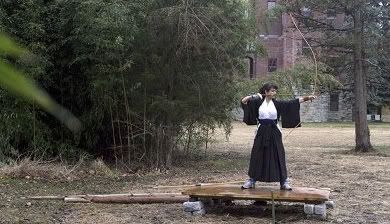
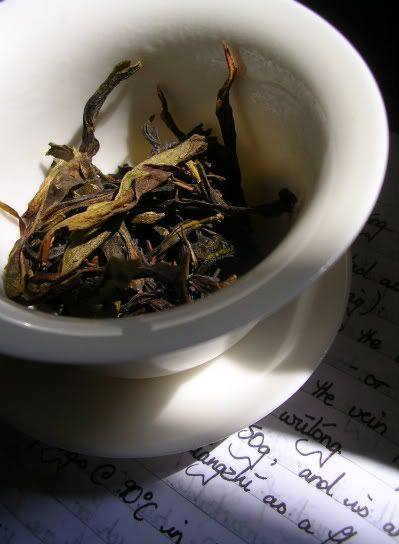
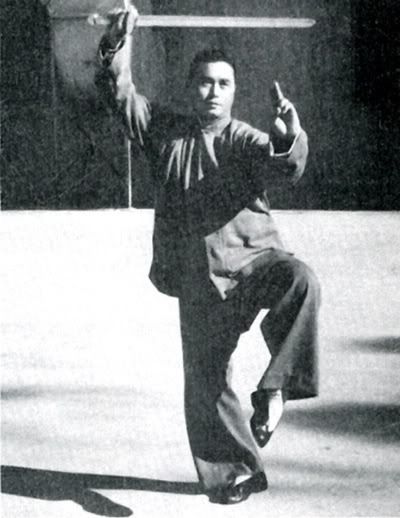
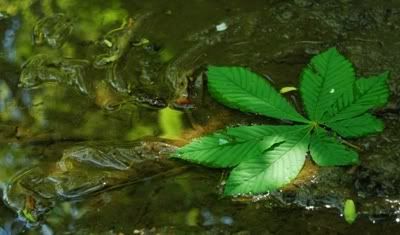
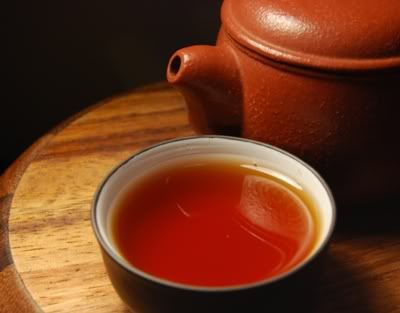
11 comments:
Sometimes, when I read a really good article, I bookmark it, so I will be able to reread it from time to time.
This is one of those articles. Thank you
Dear TA,
Well that's a big compliment, thank you. This afternoon, I'm drinking your maocha. :)
Toodlepip,
Hobbes
I had a similar experience recently.
I brought back competition grade long jing from china, but when I brewed it at home (I have a guongfu cha set up) it came out horribly bitter or so week you couldn't taste it.
so I stopped brewing the tea for a long time, deciding to stick to my whites and Oolongs which i was brewing well. About a month ago I tried brewing the dragon well again and it came out perfectly.
I could not believe the difference (or that I brewed it), for three brews it came out perfect, after that I started having problems again, but after reading your article on Zen learning it struck me what happened.
now, more often than not, I brew it well.
Dear Jason,
I find greens can be a surprisingly tricky breed to get right, and it is very interesting to read of your experience. A similarly subtle effect can sometimes be noticed if I try to really force tea to come out well - the more effort I invest, the more I try to control the variables with my rational, discursive reasoning, the harder it can be to get that tricky green to come out properly. "Don't think too much" is a famous Zen line - it seems applicable to some teas.
Japanese greens really, really get the better of me every time. No matter how hard I try, I just cannot get them to come out to my satisfaction. That I have only small experience with Japanese greens has to be related to this, and echoes some of the thoughts from the article.
*($*&£% Japanese @(£"*(£ tea. :)
Toodlepip,
Hobbes
i love it when once can see handwriting, a hint of handwriting perhaps, in a picture. I am a big tea person, I love tea. Beautiful handwriting.
Thanks, Nabeel - just the product of many years spent cartooning, oddly enough. :)
Toodlepip,
Hobbes
I love your approach, lived-experienced philosophy, exlporing harmony and balance in our mind and in our tea taste. Our mental and emotional state, when we start the act of brewing tea, influence the results...Great concept and assemblage of images and words>
Dear Giovdim,
Many thanks for the kind words.
Toodlepip,
Hobbes
I find myself thinking that the Chinese kung fu tea tools and ceremony are specially crafted for this. First you work on your outer form , then you work on your inner form.
As a wing chun and qi gong practitioner it totally makes sense to me.
Thank you for such a wonderful post. I will use it as reference for the tea related questions that people ask me.
Dear Caleaceaiului,
Thanks for the kind words!
I think you're right, regarding the chadao tools. It's a subtle thing, Chinese practicality, and has affected Zen a great deal on its journey from India to Japan.
Toodlepip,
Hobbes
Dancong on the top photo?
Great post. Psychology would call this infinitesimal subliminal apprehension or some such. It's the base of any physical exercise. Brewing tea, now that I think about it, is a physical exercise.
Best, Nerval
Post a Comment